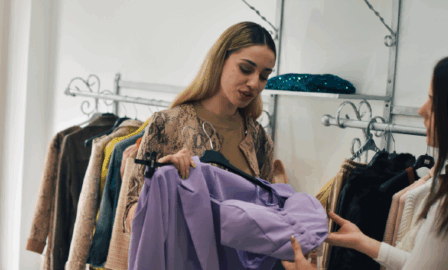The Rise of Secondhand Retail
As the 2022 holiday season approaches, we’re seeing the impact of inflation continue to hit shoppers’ wallets – they’re either limiting their spending completely or turning to secondhand retail as an option for gift giving. A recent study found that 25% of shoppers plan to purchase used gifts as a way to cut back on their total costs this year. The concept of secondhand retail, however, is nothing new, as the COVID-19 pandemic and shoppers’ increased desire for sustainability shifted shopper habits and behavior across industries.
Resale – this small but growing category of retail has received increasing amounts of attention in the last few years, particularly since the IPO of ThredUp, one of the largest online consignment/secondhand retail platforms. Though resale only represents a tiny sliver of the overall Retail market, there are multiple indicators to suggest there is significant potential for growth. The confluence of sustainability, price-sensitivity, and eCommerce trends leads to a retail environment that is primed for resale opportunities. In fact, one study released in ThredUp’s annual report projected that the total resale market will grow to almost twice the size of fast fashion by 2029.
Given these impressive projections and resale’s potential to contribute to a circular economy, many retailers are exploring ways to participate in the category. But if there’s one clear theme, it’s that there is no one right way to break into resale. Almost every example of a resale platform or partnership has some nuance that makes it right for a particular retailer. Finding that perfect model requires an honest analysis of current capabilities and vision for the future.
The first step to determine the optimal resale play is to understand what options already exist. There are three main categories of secondhand retail or “circular economy” models:
3rd Party Partnership: this model, in which a retailer partners with a resale platform, has become prolific due to the relative simplicity of implementation. The partnership model, however, can vary. For example, Gap’s partnership with ThredUp involves placing secondhand clothing collection bins at Gap stores and providing customers with 15% coupons in exchange for dropping off their used clothing. Madewell, on the other hand, structured its partnership with ThredUp differently. Madewell receives their own brand denim that has been sent by customers to the platform, then refurbishes it and re-sells in stores. Walmart showcases a third iteration of the partnership model, in which it sells ThredUp merchandise directly through its own website. Though these are just three examples, they showcase the wide range of possibilities that a partnership can offer. Not to mention, there are multiple options for companies to partner with – beyond ThredUp, there is also The RealReal, Stuffstr, and FashionPhile, to name a few.
Owned Platform: some brands opt for a more direct involvement in the resale category by creating their own platform. There are several Resale-as-a-Service (RaaS) providers that offer backend infrastructure and support for the operational capabilities that are required to execute resale, from reverse logistics, cleaning, pricing, photography, and everything in between.. Examples of such vendors include Archive, Trove, and Reflaunt. Working with any of these companies allows brands to create a customized marketplace for their secondhand category while outsourcing some of the aforementioned capabilities. This is a popular option for retailers that want to keep a pulse on the customer data, control the brand positioning, and are willing to make a larger investment to do so. Eileen Fisher’s resale clothing line, Renew, is actually growing faster than its main-line sales. Nordstrom is another example of a retailer that has opted for creating its own resale platform, but in this case has partnered with Goodfair – an online thrift store. In this model, Nordstrom purchases product from Goodfair and sells it directly through the Nordstrom website. This new initiative seems to be going well, with Nordstrom tripling its order after the initial run sold out within 24 hours.
Recycled, not Refurbished: this model is not quite resale of existing product, but recycling to create new products. It is certainly a challenging and likely less cost-effective option for most brands, but worth considering because it creates new corridors for sustainable innovation. After all, resale by itself does not close the loop of a circular model. With recycling, retailers take used product from customers, break it down to the raw materials, and use those to create net-new products. Two companies experimenting with this approach are Apple and Patagonia, both of whom view their recycling programs as important investments for future sustainability capabilities.
Choosing the right re-commerce model may be daunting, but it begins with a few key considerations:
- Technology capabilities: a retailer’s level of ecommerce maturity and the design of the ecommerce presence is a consideration for selecting a resale model. While there are some exceptions, the majority of retailers do leverage ecommerce for resale by logic of the long-tail phenomenon. That being said, depending on the robustness of a retailer’s web presence, they can choose to sell directly or through a third-party.
- Logistic capabilities: in deciding how to implement resale, it’s important to consider all of the logistics involved – collecting product, cleaning it, tagging it, photographing, merchandising, sending back out to customers, and everything in between. Retailers will vary in the level of hands-on involvement they want to have and can scale.
- The product itself: different resale models may be appropriate depending on the nature of the product. For example, if a retailer’s product is designed for longevity (both in durability and style) then it is a great candidate for resale. If the raw materials are valuable to be recycled, then that may be the best route.
- The future vision: a crucial step in making the decision on resale is to understand how it fits with the brand’s overall strategy. Is resale a significant contributor to the retailer’s sustainability goals? Will it influence product design in the future? What are the customer needs today and how will they change? Asking these types of questions as part of the decision-making process will help to ensure that the investment has the greatest chance to grow into a meaningful contributor to the bottom line.
Secondhand retail is a growing segment of the overall resale market and many retailers want to get in early. If you are thinking about how to incorporate resale into your business, reach out to our retail experts. We can support across all stages of the process – from evaluating resale at a strategic level, assessing technological and operational capabilities, finding the optimal resale partner, to building out an eCommerce solution.
Subscribe to Clarkston's Insights
Contributions by Robin Dolan



